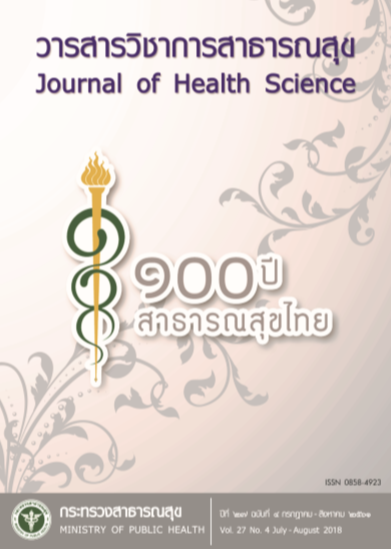Accuracy of Early Diagnosis of Dengue Hemorrhagic Fever with Confirmation by Detection of IgM and IgG Antibodies by ELISA Technique, Krabi Province
Keywords:
dengue hemorrhagic fever, factors related to, accuracy, diagnosisAbstract
Dengue hemorrhagic fever is a disease that has spread in Krabi Province and has been high prevalence in Thailand. The objectives of this research were to study the basic characteristics and types of dengue fever in patients admitted to Krabi Hospital, and asses the accuracy of dengue diagnosis of medical personnel at Krabi Hospital. It was a cross-sectional descriptive research. Data were collected from patient records with dengue hemorrhagic fever as the samples of 343 patients in Krabi Province during the period 2013 - 2015; and were analyzed by descriptive statistics, together with Pearson's correlation coefficient to test the relationship of the data. Diagnostic accuracy test with sensitivity, specificity positive predictive value and negative predictive value were calculated by using statistical software. The results showed that 52.48% of the cases were female with the mean age of 18.89 years (SD=13.71). Most of them were 5 - 9 years old (21.40%), followed by 10 - 14 years old (14.30%). Most of the patients lived in Muang Krabi District (80.47%), followed by Nuaklong District (9.04%). The most common diagnoses were dengue hemorrhagic fever (DHF) (73.18%), followed by dengue fever (DF) and dengue shock syndrome (DSS) (24.78% and 2.04% respectively). The range of illness varied from 2 to 12 days; and the mean period of illness was 5.13 days (SD=1.44). Patients had a pre-existing medical condition ranging from 1 to 5 days, and the average duration of fever was 1.21 days (SD=1.38). Analysis of the effectiveness of the diagnostic accuracy for the primary diagnosis in patients with clinically suspected dengue fever, keeping dengue IgM/IgG as gold standard, showed 95.94% sensitivity, 83.33% specificity, 95.59% positive predictive value, 84.51% negative predictive value, and 93.29% accuracy. The results of this study concluded that the diagnoses of the physicians were very accurate. The older patients recovered faster than the younger cases. The suggestions from this research was to advise patients to seek immediate medical attention in order to reduce the risk of high fever and high white blood cells. It was observed that younger patients were at greater risk of low platelets; and they were at higher risk of death.
Downloads
Downloads
Published
How to Cite
Issue
Section
License
Copyright (c) 2018 Journal of Health Science- วารสารวิชาการสาธารณสุข

This work is licensed under a Creative Commons Attribution-NonCommercial-NoDerivatives 4.0 International License.







